Comprehensive Report on Clinical Leadership in Nursing Practice
VerifiedAdded on 2021/06/15
|25
|6367
|429
Report
AI Summary
This report provides a comprehensive overview of clinical leadership in nursing, emphasizing its importance in delivering quality patient care and fostering professional development. It explores various domains of clinical leadership, including personal qualities, teamwork, service management, direction setting, and service improvement. The report also delves into the roles of clinical leaders in budgetary allocation, curriculum evaluation, and advocacy for nurses' rights. The literature review highlights the significance of nurse leaders in ensuring effective, safe, and high-quality services, as well as their role in advocating for nurses' well-being. The project plan outlines the goal of understanding clinical leadership roles, expectations, objectives, and key outcomes, along with resources and evaluation methods. The report concludes by underscoring the critical role of clinical leadership in shaping the nursing profession and ensuring optimal patient outcomes.
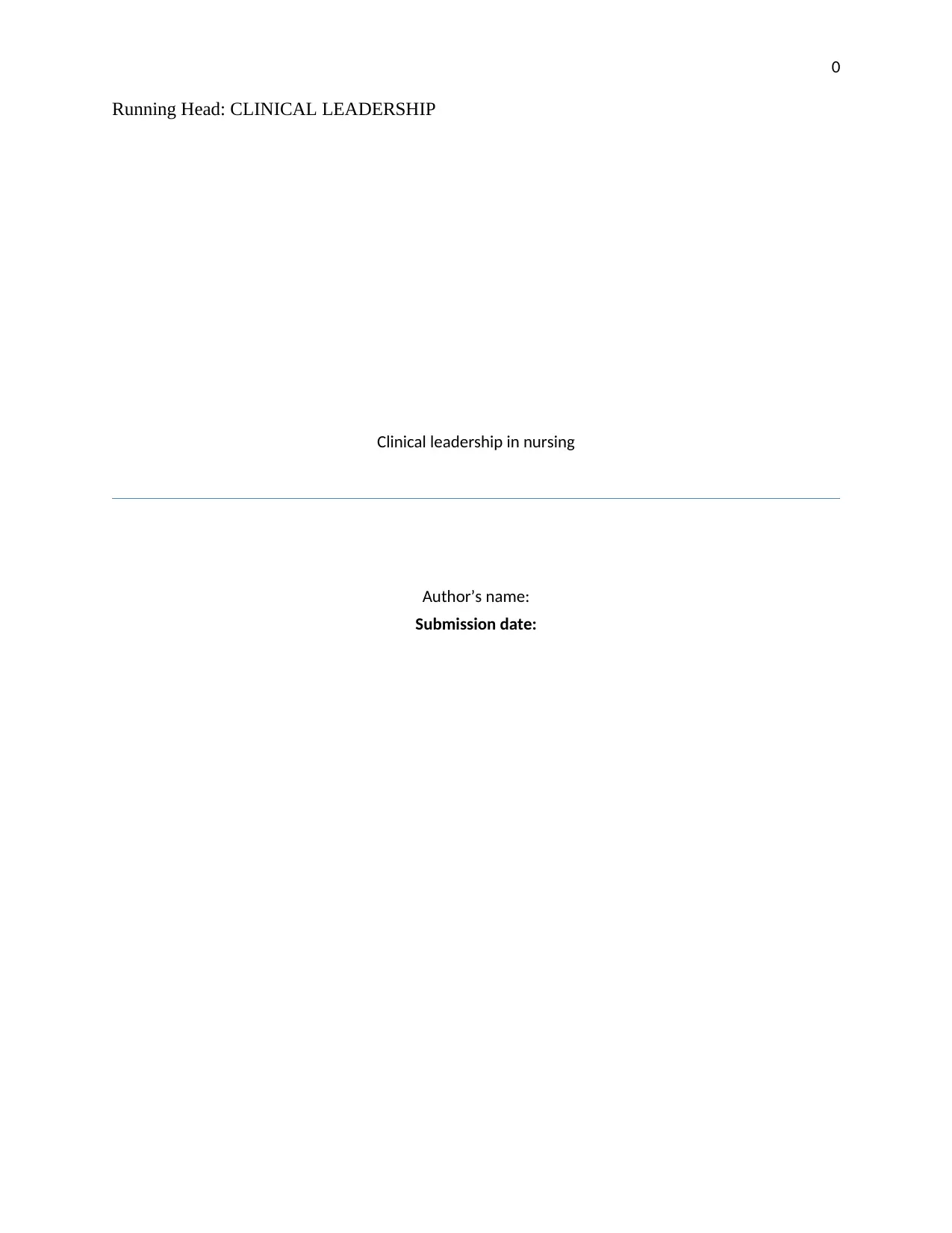
0
Running Head: CLINICAL LEADERSHIP
Clinical leadership in nursing
Author’s name:
Submission date:
Running Head: CLINICAL LEADERSHIP
Clinical leadership in nursing
Author’s name:
Submission date:
Paraphrase This Document
Need a fresh take? Get an instant paraphrase of this document with our AI Paraphraser
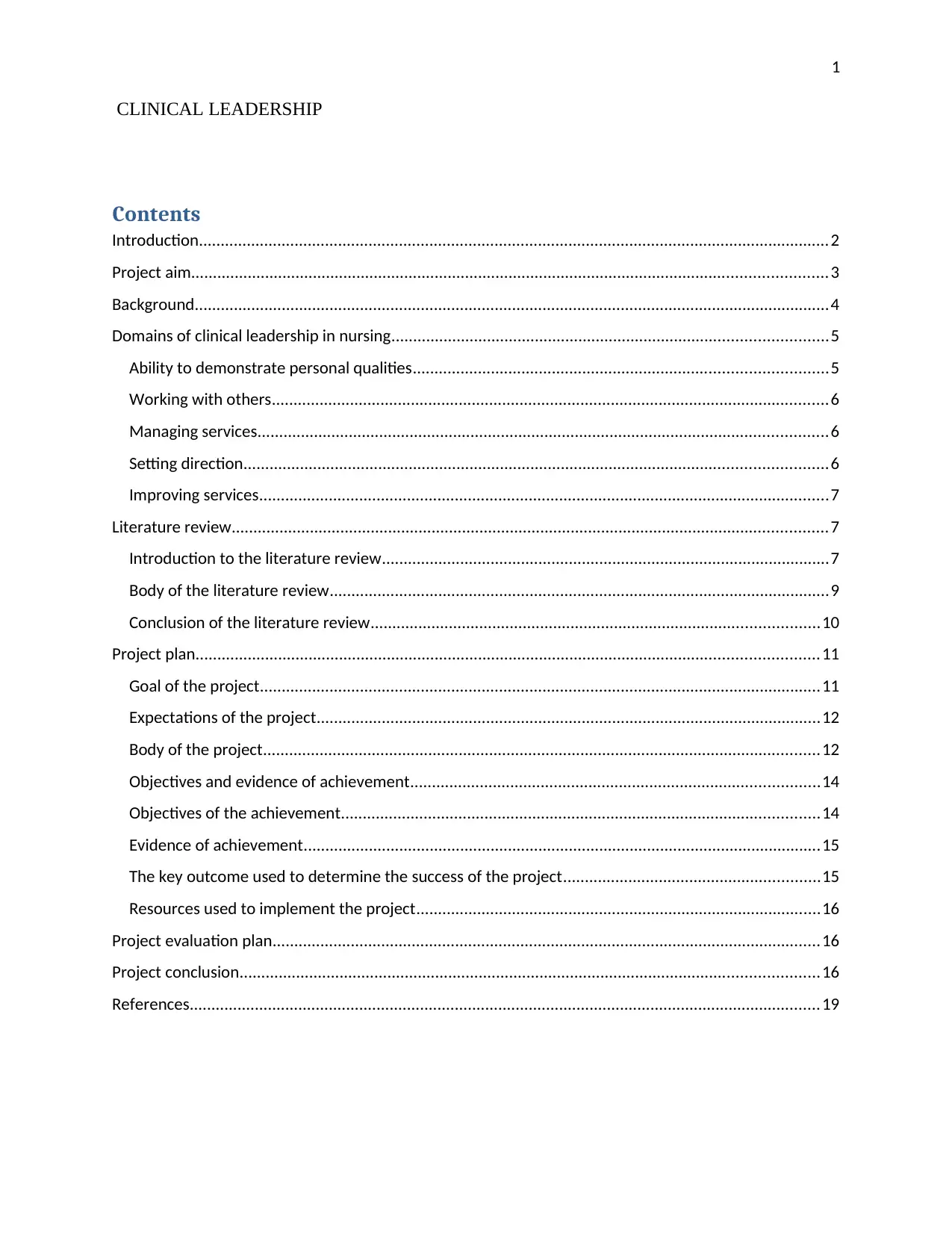
1
CLINICAL LEADERSHIP
Contents
Introduction.................................................................................................................................................2
Project aim..................................................................................................................................................3
Background..................................................................................................................................................4
Domains of clinical leadership in nursing....................................................................................................5
Ability to demonstrate personal qualities...............................................................................................5
Working with others................................................................................................................................6
Managing services...................................................................................................................................6
Setting direction......................................................................................................................................6
Improving services...................................................................................................................................7
Literature review.........................................................................................................................................7
Introduction to the literature review.......................................................................................................7
Body of the literature review...................................................................................................................9
Conclusion of the literature review.......................................................................................................10
Project plan...............................................................................................................................................11
Goal of the project.................................................................................................................................11
Expectations of the project....................................................................................................................12
Body of the project................................................................................................................................12
Objectives and evidence of achievement..............................................................................................14
Objectives of the achievement..............................................................................................................14
Evidence of achievement.......................................................................................................................15
The key outcome used to determine the success of the project...........................................................15
Resources used to implement the project.............................................................................................16
Project evaluation plan..............................................................................................................................16
Project conclusion.....................................................................................................................................16
References.................................................................................................................................................19
CLINICAL LEADERSHIP
Contents
Introduction.................................................................................................................................................2
Project aim..................................................................................................................................................3
Background..................................................................................................................................................4
Domains of clinical leadership in nursing....................................................................................................5
Ability to demonstrate personal qualities...............................................................................................5
Working with others................................................................................................................................6
Managing services...................................................................................................................................6
Setting direction......................................................................................................................................6
Improving services...................................................................................................................................7
Literature review.........................................................................................................................................7
Introduction to the literature review.......................................................................................................7
Body of the literature review...................................................................................................................9
Conclusion of the literature review.......................................................................................................10
Project plan...............................................................................................................................................11
Goal of the project.................................................................................................................................11
Expectations of the project....................................................................................................................12
Body of the project................................................................................................................................12
Objectives and evidence of achievement..............................................................................................14
Objectives of the achievement..............................................................................................................14
Evidence of achievement.......................................................................................................................15
The key outcome used to determine the success of the project...........................................................15
Resources used to implement the project.............................................................................................16
Project evaluation plan..............................................................................................................................16
Project conclusion.....................................................................................................................................16
References.................................................................................................................................................19
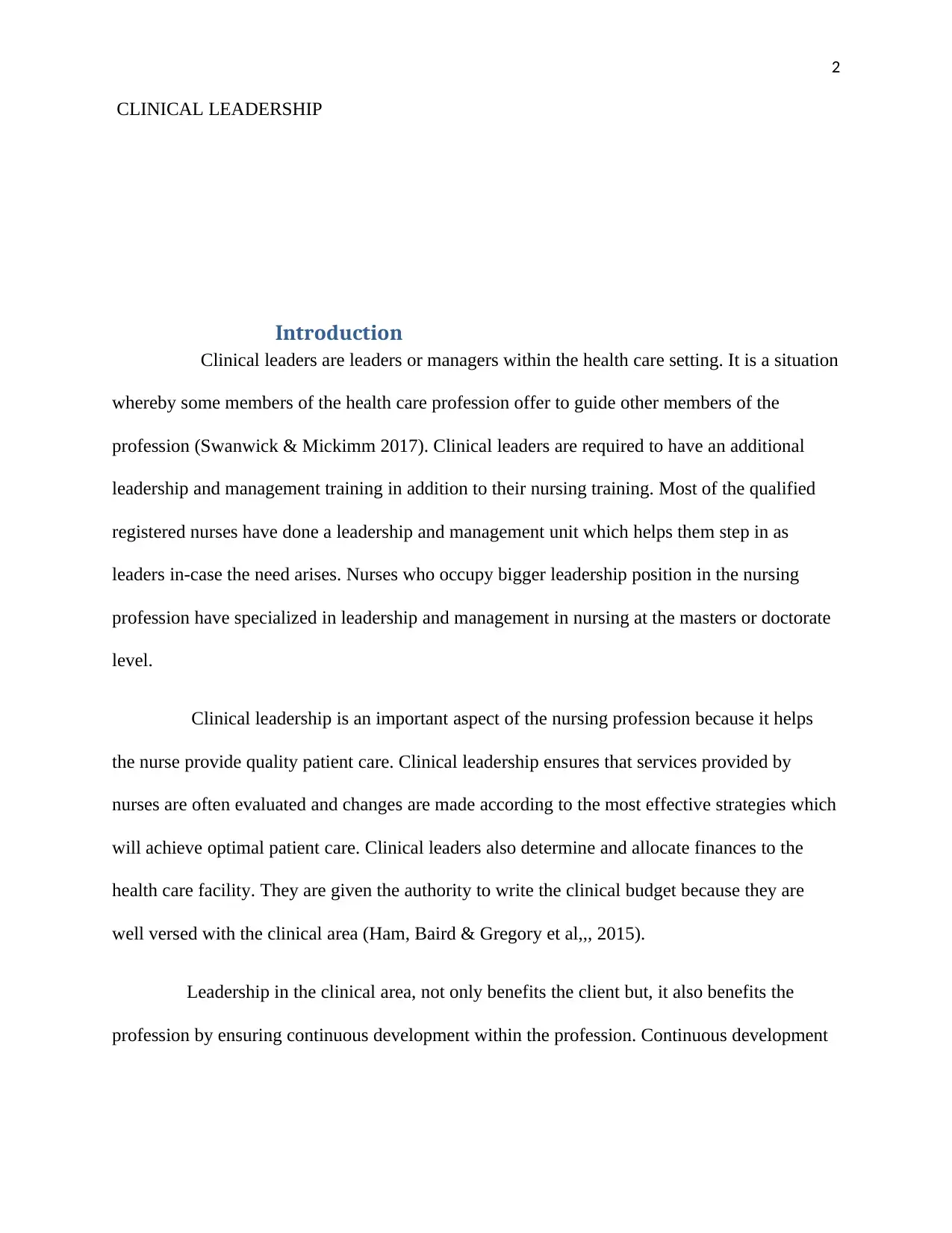
2
CLINICAL LEADERSHIP
Introduction
Clinical leaders are leaders or managers within the health care setting. It is a situation
whereby some members of the health care profession offer to guide other members of the
profession (Swanwick & Mickimm 2017). Clinical leaders are required to have an additional
leadership and management training in addition to their nursing training. Most of the qualified
registered nurses have done a leadership and management unit which helps them step in as
leaders in-case the need arises. Nurses who occupy bigger leadership position in the nursing
profession have specialized in leadership and management in nursing at the masters or doctorate
level.
Clinical leadership is an important aspect of the nursing profession because it helps
the nurse provide quality patient care. Clinical leadership ensures that services provided by
nurses are often evaluated and changes are made according to the most effective strategies which
will achieve optimal patient care. Clinical leaders also determine and allocate finances to the
health care facility. They are given the authority to write the clinical budget because they are
well versed with the clinical area (Ham, Baird & Gregory et al,,, 2015).
Leadership in the clinical area, not only benefits the client but, it also benefits the
profession by ensuring continuous development within the profession. Continuous development
CLINICAL LEADERSHIP
Introduction
Clinical leaders are leaders or managers within the health care setting. It is a situation
whereby some members of the health care profession offer to guide other members of the
profession (Swanwick & Mickimm 2017). Clinical leaders are required to have an additional
leadership and management training in addition to their nursing training. Most of the qualified
registered nurses have done a leadership and management unit which helps them step in as
leaders in-case the need arises. Nurses who occupy bigger leadership position in the nursing
profession have specialized in leadership and management in nursing at the masters or doctorate
level.
Clinical leadership is an important aspect of the nursing profession because it helps
the nurse provide quality patient care. Clinical leadership ensures that services provided by
nurses are often evaluated and changes are made according to the most effective strategies which
will achieve optimal patient care. Clinical leaders also determine and allocate finances to the
health care facility. They are given the authority to write the clinical budget because they are
well versed with the clinical area (Ham, Baird & Gregory et al,,, 2015).
Leadership in the clinical area, not only benefits the client but, it also benefits the
profession by ensuring continuous development within the profession. Continuous development
⊘ This is a preview!⊘
Do you want full access?
Subscribe today to unlock all pages.

Trusted by 1+ million students worldwide
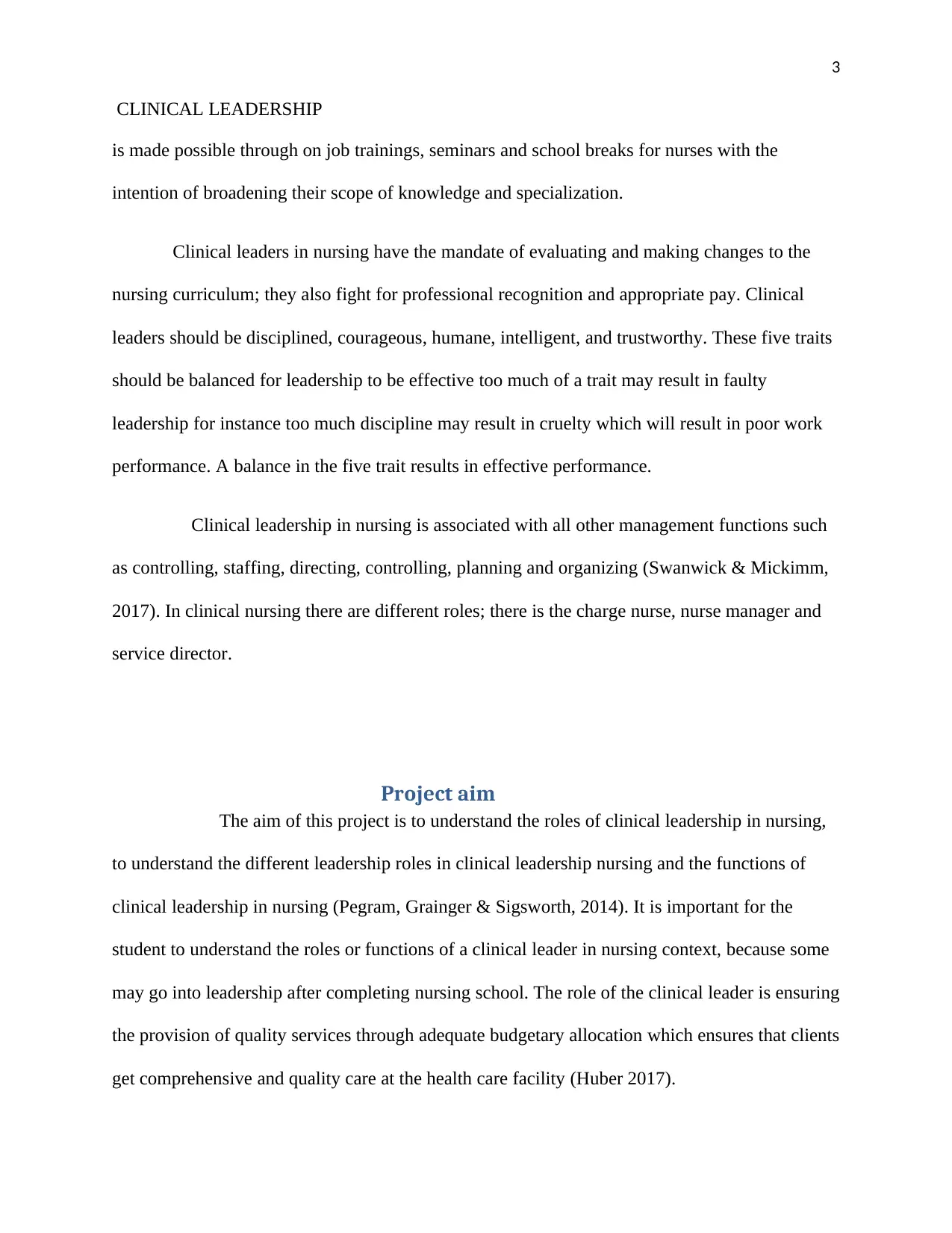
3
CLINICAL LEADERSHIP
is made possible through on job trainings, seminars and school breaks for nurses with the
intention of broadening their scope of knowledge and specialization.
Clinical leaders in nursing have the mandate of evaluating and making changes to the
nursing curriculum; they also fight for professional recognition and appropriate pay. Clinical
leaders should be disciplined, courageous, humane, intelligent, and trustworthy. These five traits
should be balanced for leadership to be effective too much of a trait may result in faulty
leadership for instance too much discipline may result in cruelty which will result in poor work
performance. A balance in the five trait results in effective performance.
Clinical leadership in nursing is associated with all other management functions such
as controlling, staffing, directing, controlling, planning and organizing (Swanwick & Mickimm,
2017). In clinical nursing there are different roles; there is the charge nurse, nurse manager and
service director.
Project aim
The aim of this project is to understand the roles of clinical leadership in nursing,
to understand the different leadership roles in clinical leadership nursing and the functions of
clinical leadership in nursing (Pegram, Grainger & Sigsworth, 2014). It is important for the
student to understand the roles or functions of a clinical leader in nursing context, because some
may go into leadership after completing nursing school. The role of the clinical leader is ensuring
the provision of quality services through adequate budgetary allocation which ensures that clients
get comprehensive and quality care at the health care facility (Huber 2017).
CLINICAL LEADERSHIP
is made possible through on job trainings, seminars and school breaks for nurses with the
intention of broadening their scope of knowledge and specialization.
Clinical leaders in nursing have the mandate of evaluating and making changes to the
nursing curriculum; they also fight for professional recognition and appropriate pay. Clinical
leaders should be disciplined, courageous, humane, intelligent, and trustworthy. These five traits
should be balanced for leadership to be effective too much of a trait may result in faulty
leadership for instance too much discipline may result in cruelty which will result in poor work
performance. A balance in the five trait results in effective performance.
Clinical leadership in nursing is associated with all other management functions such
as controlling, staffing, directing, controlling, planning and organizing (Swanwick & Mickimm,
2017). In clinical nursing there are different roles; there is the charge nurse, nurse manager and
service director.
Project aim
The aim of this project is to understand the roles of clinical leadership in nursing,
to understand the different leadership roles in clinical leadership nursing and the functions of
clinical leadership in nursing (Pegram, Grainger & Sigsworth, 2014). It is important for the
student to understand the roles or functions of a clinical leader in nursing context, because some
may go into leadership after completing nursing school. The role of the clinical leader is ensuring
the provision of quality services through adequate budgetary allocation which ensures that clients
get comprehensive and quality care at the health care facility (Huber 2017).
Paraphrase This Document
Need a fresh take? Get an instant paraphrase of this document with our AI Paraphraser
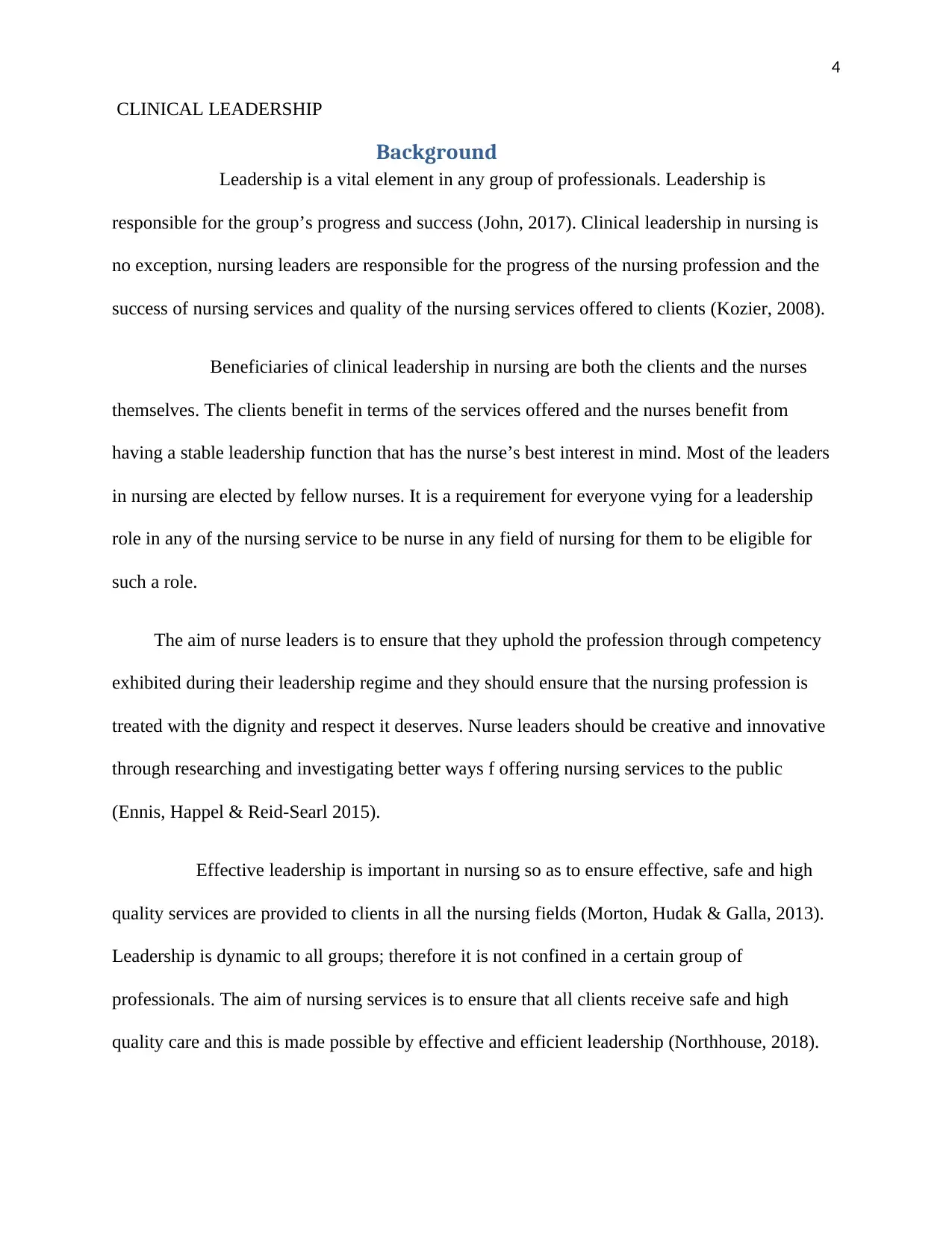
4
CLINICAL LEADERSHIP
Background
Leadership is a vital element in any group of professionals. Leadership is
responsible for the group’s progress and success (John, 2017). Clinical leadership in nursing is
no exception, nursing leaders are responsible for the progress of the nursing profession and the
success of nursing services and quality of the nursing services offered to clients (Kozier, 2008).
Beneficiaries of clinical leadership in nursing are both the clients and the nurses
themselves. The clients benefit in terms of the services offered and the nurses benefit from
having a stable leadership function that has the nurse’s best interest in mind. Most of the leaders
in nursing are elected by fellow nurses. It is a requirement for everyone vying for a leadership
role in any of the nursing service to be nurse in any field of nursing for them to be eligible for
such a role.
The aim of nurse leaders is to ensure that they uphold the profession through competency
exhibited during their leadership regime and they should ensure that the nursing profession is
treated with the dignity and respect it deserves. Nurse leaders should be creative and innovative
through researching and investigating better ways f offering nursing services to the public
(Ennis, Happel & Reid-Searl 2015).
Effective leadership is important in nursing so as to ensure effective, safe and high
quality services are provided to clients in all the nursing fields (Morton, Hudak & Galla, 2013).
Leadership is dynamic to all groups; therefore it is not confined in a certain group of
professionals. The aim of nursing services is to ensure that all clients receive safe and high
quality care and this is made possible by effective and efficient leadership (Northhouse, 2018).
CLINICAL LEADERSHIP
Background
Leadership is a vital element in any group of professionals. Leadership is
responsible for the group’s progress and success (John, 2017). Clinical leadership in nursing is
no exception, nursing leaders are responsible for the progress of the nursing profession and the
success of nursing services and quality of the nursing services offered to clients (Kozier, 2008).
Beneficiaries of clinical leadership in nursing are both the clients and the nurses
themselves. The clients benefit in terms of the services offered and the nurses benefit from
having a stable leadership function that has the nurse’s best interest in mind. Most of the leaders
in nursing are elected by fellow nurses. It is a requirement for everyone vying for a leadership
role in any of the nursing service to be nurse in any field of nursing for them to be eligible for
such a role.
The aim of nurse leaders is to ensure that they uphold the profession through competency
exhibited during their leadership regime and they should ensure that the nursing profession is
treated with the dignity and respect it deserves. Nurse leaders should be creative and innovative
through researching and investigating better ways f offering nursing services to the public
(Ennis, Happel & Reid-Searl 2015).
Effective leadership is important in nursing so as to ensure effective, safe and high
quality services are provided to clients in all the nursing fields (Morton, Hudak & Galla, 2013).
Leadership is dynamic to all groups; therefore it is not confined in a certain group of
professionals. The aim of nursing services is to ensure that all clients receive safe and high
quality care and this is made possible by effective and efficient leadership (Northhouse, 2018).
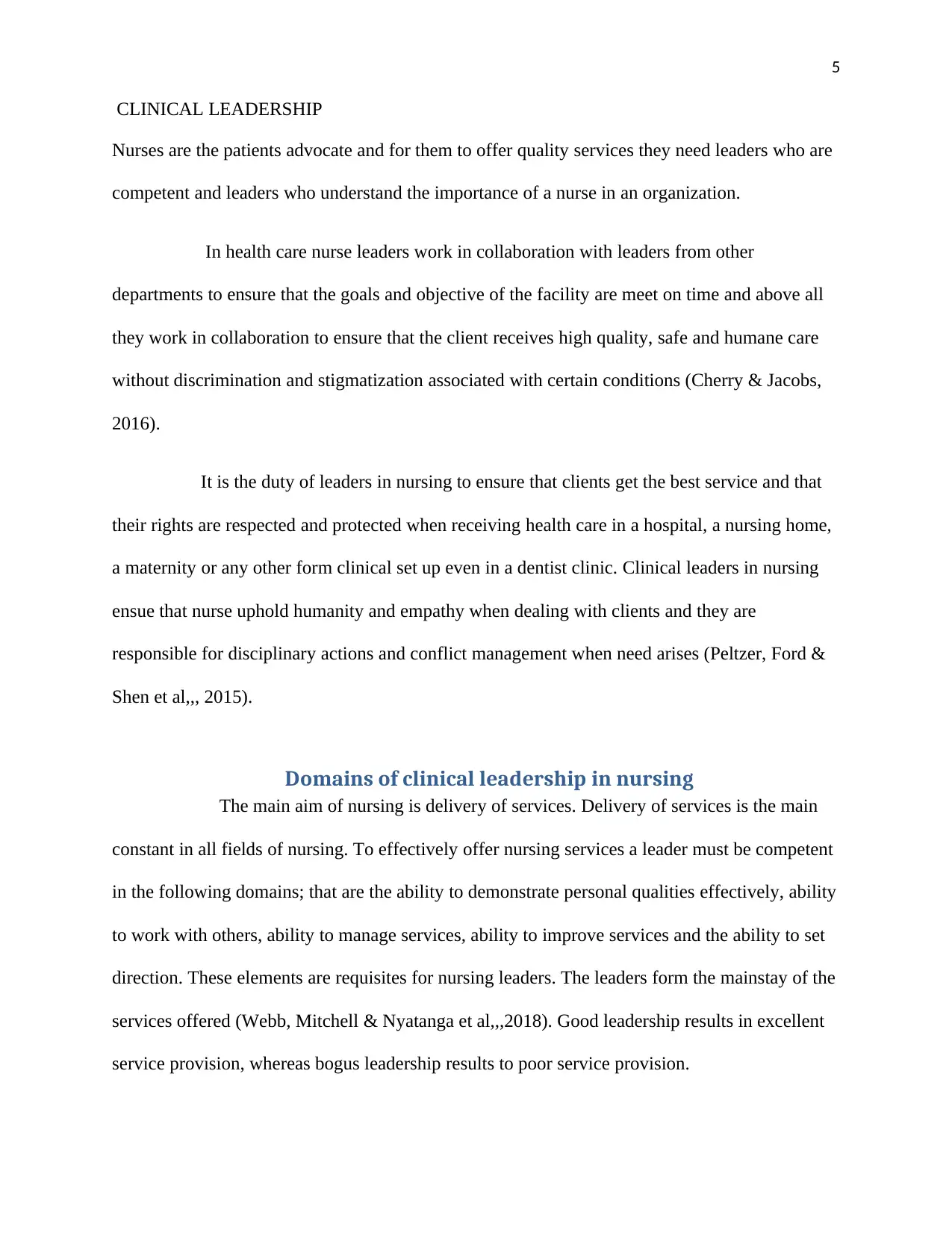
5
CLINICAL LEADERSHIP
Nurses are the patients advocate and for them to offer quality services they need leaders who are
competent and leaders who understand the importance of a nurse in an organization.
In health care nurse leaders work in collaboration with leaders from other
departments to ensure that the goals and objective of the facility are meet on time and above all
they work in collaboration to ensure that the client receives high quality, safe and humane care
without discrimination and stigmatization associated with certain conditions (Cherry & Jacobs,
2016).
It is the duty of leaders in nursing to ensure that clients get the best service and that
their rights are respected and protected when receiving health care in a hospital, a nursing home,
a maternity or any other form clinical set up even in a dentist clinic. Clinical leaders in nursing
ensue that nurse uphold humanity and empathy when dealing with clients and they are
responsible for disciplinary actions and conflict management when need arises (Peltzer, Ford &
Shen et al,,, 2015).
Domains of clinical leadership in nursing
The main aim of nursing is delivery of services. Delivery of services is the main
constant in all fields of nursing. To effectively offer nursing services a leader must be competent
in the following domains; that are the ability to demonstrate personal qualities effectively, ability
to work with others, ability to manage services, ability to improve services and the ability to set
direction. These elements are requisites for nursing leaders. The leaders form the mainstay of the
services offered (Webb, Mitchell & Nyatanga et al,,,2018). Good leadership results in excellent
service provision, whereas bogus leadership results to poor service provision.
CLINICAL LEADERSHIP
Nurses are the patients advocate and for them to offer quality services they need leaders who are
competent and leaders who understand the importance of a nurse in an organization.
In health care nurse leaders work in collaboration with leaders from other
departments to ensure that the goals and objective of the facility are meet on time and above all
they work in collaboration to ensure that the client receives high quality, safe and humane care
without discrimination and stigmatization associated with certain conditions (Cherry & Jacobs,
2016).
It is the duty of leaders in nursing to ensure that clients get the best service and that
their rights are respected and protected when receiving health care in a hospital, a nursing home,
a maternity or any other form clinical set up even in a dentist clinic. Clinical leaders in nursing
ensue that nurse uphold humanity and empathy when dealing with clients and they are
responsible for disciplinary actions and conflict management when need arises (Peltzer, Ford &
Shen et al,,, 2015).
Domains of clinical leadership in nursing
The main aim of nursing is delivery of services. Delivery of services is the main
constant in all fields of nursing. To effectively offer nursing services a leader must be competent
in the following domains; that are the ability to demonstrate personal qualities effectively, ability
to work with others, ability to manage services, ability to improve services and the ability to set
direction. These elements are requisites for nursing leaders. The leaders form the mainstay of the
services offered (Webb, Mitchell & Nyatanga et al,,,2018). Good leadership results in excellent
service provision, whereas bogus leadership results to poor service provision.
⊘ This is a preview!⊘
Do you want full access?
Subscribe today to unlock all pages.

Trusted by 1+ million students worldwide
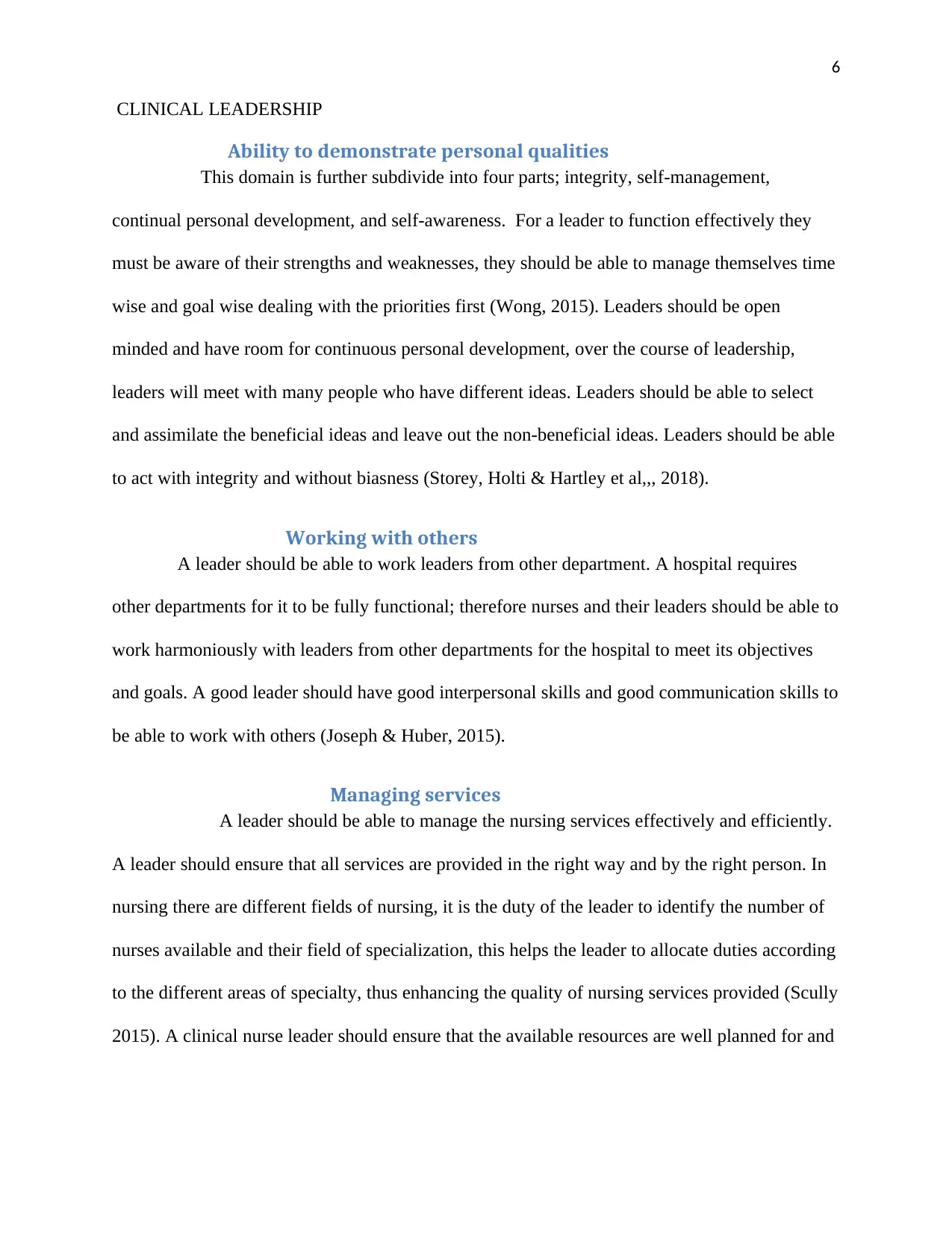
6
CLINICAL LEADERSHIP
Ability to demonstrate personal qualities
This domain is further subdivide into four parts; integrity, self-management,
continual personal development, and self-awareness. For a leader to function effectively they
must be aware of their strengths and weaknesses, they should be able to manage themselves time
wise and goal wise dealing with the priorities first (Wong, 2015). Leaders should be open
minded and have room for continuous personal development, over the course of leadership,
leaders will meet with many people who have different ideas. Leaders should be able to select
and assimilate the beneficial ideas and leave out the non-beneficial ideas. Leaders should be able
to act with integrity and without biasness (Storey, Holti & Hartley et al,,, 2018).
Working with others
A leader should be able to work leaders from other department. A hospital requires
other departments for it to be fully functional; therefore nurses and their leaders should be able to
work harmoniously with leaders from other departments for the hospital to meet its objectives
and goals. A good leader should have good interpersonal skills and good communication skills to
be able to work with others (Joseph & Huber, 2015).
Managing services
A leader should be able to manage the nursing services effectively and efficiently.
A leader should ensure that all services are provided in the right way and by the right person. In
nursing there are different fields of nursing, it is the duty of the leader to identify the number of
nurses available and their field of specialization, this helps the leader to allocate duties according
to the different areas of specialty, thus enhancing the quality of nursing services provided (Scully
2015). A clinical nurse leader should ensure that the available resources are well planned for and
CLINICAL LEADERSHIP
Ability to demonstrate personal qualities
This domain is further subdivide into four parts; integrity, self-management,
continual personal development, and self-awareness. For a leader to function effectively they
must be aware of their strengths and weaknesses, they should be able to manage themselves time
wise and goal wise dealing with the priorities first (Wong, 2015). Leaders should be open
minded and have room for continuous personal development, over the course of leadership,
leaders will meet with many people who have different ideas. Leaders should be able to select
and assimilate the beneficial ideas and leave out the non-beneficial ideas. Leaders should be able
to act with integrity and without biasness (Storey, Holti & Hartley et al,,, 2018).
Working with others
A leader should be able to work leaders from other department. A hospital requires
other departments for it to be fully functional; therefore nurses and their leaders should be able to
work harmoniously with leaders from other departments for the hospital to meet its objectives
and goals. A good leader should have good interpersonal skills and good communication skills to
be able to work with others (Joseph & Huber, 2015).
Managing services
A leader should be able to manage the nursing services effectively and efficiently.
A leader should ensure that all services are provided in the right way and by the right person. In
nursing there are different fields of nursing, it is the duty of the leader to identify the number of
nurses available and their field of specialization, this helps the leader to allocate duties according
to the different areas of specialty, thus enhancing the quality of nursing services provided (Scully
2015). A clinical nurse leader should ensure that the available resources are well planned for and
Paraphrase This Document
Need a fresh take? Get an instant paraphrase of this document with our AI Paraphraser
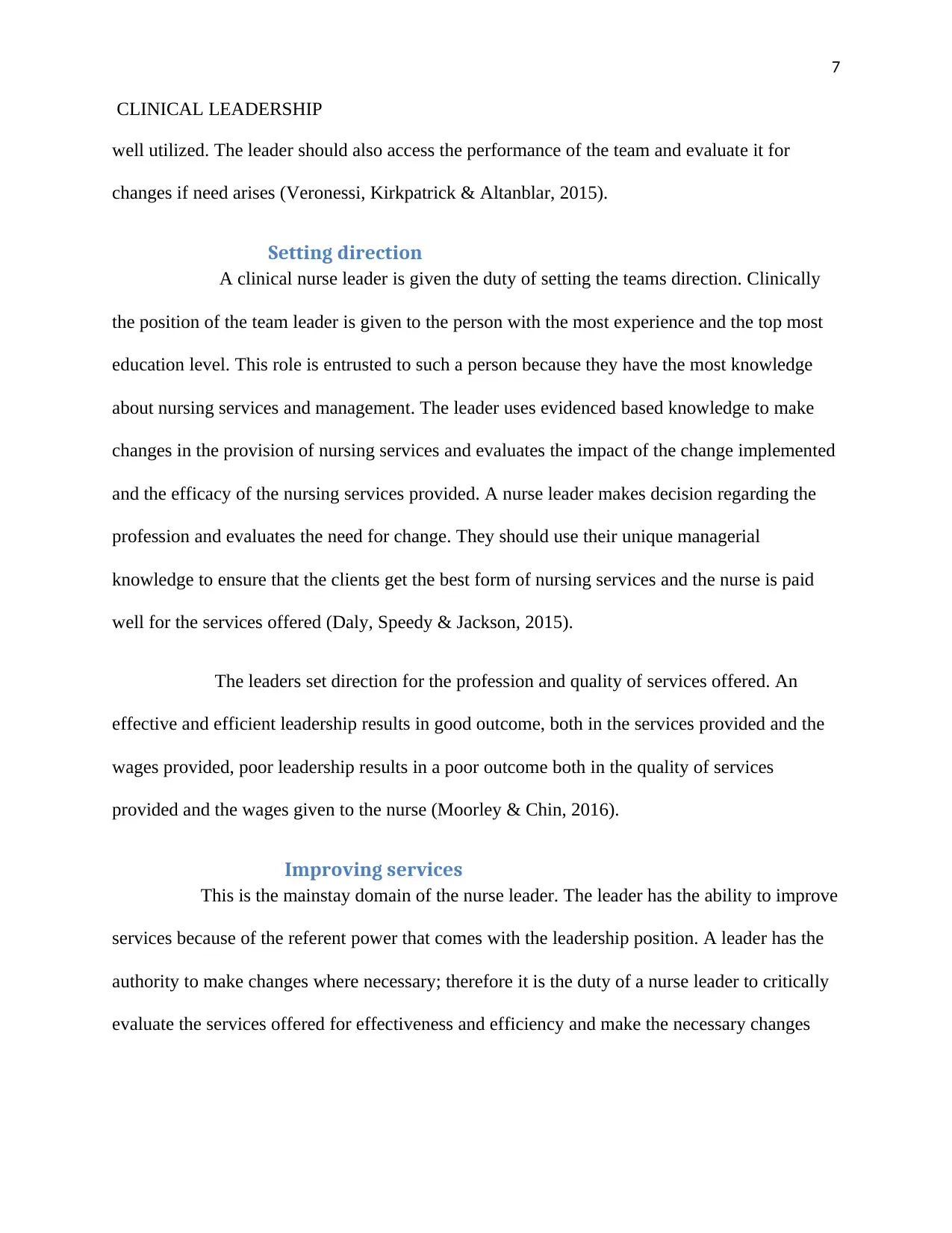
7
CLINICAL LEADERSHIP
well utilized. The leader should also access the performance of the team and evaluate it for
changes if need arises (Veronessi, Kirkpatrick & Altanblar, 2015).
Setting direction
A clinical nurse leader is given the duty of setting the teams direction. Clinically
the position of the team leader is given to the person with the most experience and the top most
education level. This role is entrusted to such a person because they have the most knowledge
about nursing services and management. The leader uses evidenced based knowledge to make
changes in the provision of nursing services and evaluates the impact of the change implemented
and the efficacy of the nursing services provided. A nurse leader makes decision regarding the
profession and evaluates the need for change. They should use their unique managerial
knowledge to ensure that the clients get the best form of nursing services and the nurse is paid
well for the services offered (Daly, Speedy & Jackson, 2015).
The leaders set direction for the profession and quality of services offered. An
effective and efficient leadership results in good outcome, both in the services provided and the
wages provided, poor leadership results in a poor outcome both in the quality of services
provided and the wages given to the nurse (Moorley & Chin, 2016).
Improving services
This is the mainstay domain of the nurse leader. The leader has the ability to improve
services because of the referent power that comes with the leadership position. A leader has the
authority to make changes where necessary; therefore it is the duty of a nurse leader to critically
evaluate the services offered for effectiveness and efficiency and make the necessary changes
CLINICAL LEADERSHIP
well utilized. The leader should also access the performance of the team and evaluate it for
changes if need arises (Veronessi, Kirkpatrick & Altanblar, 2015).
Setting direction
A clinical nurse leader is given the duty of setting the teams direction. Clinically
the position of the team leader is given to the person with the most experience and the top most
education level. This role is entrusted to such a person because they have the most knowledge
about nursing services and management. The leader uses evidenced based knowledge to make
changes in the provision of nursing services and evaluates the impact of the change implemented
and the efficacy of the nursing services provided. A nurse leader makes decision regarding the
profession and evaluates the need for change. They should use their unique managerial
knowledge to ensure that the clients get the best form of nursing services and the nurse is paid
well for the services offered (Daly, Speedy & Jackson, 2015).
The leaders set direction for the profession and quality of services offered. An
effective and efficient leadership results in good outcome, both in the services provided and the
wages provided, poor leadership results in a poor outcome both in the quality of services
provided and the wages given to the nurse (Moorley & Chin, 2016).
Improving services
This is the mainstay domain of the nurse leader. The leader has the ability to improve
services because of the referent power that comes with the leadership position. A leader has the
authority to make changes where necessary; therefore it is the duty of a nurse leader to critically
evaluate the services offered for effectiveness and efficiency and make the necessary changes
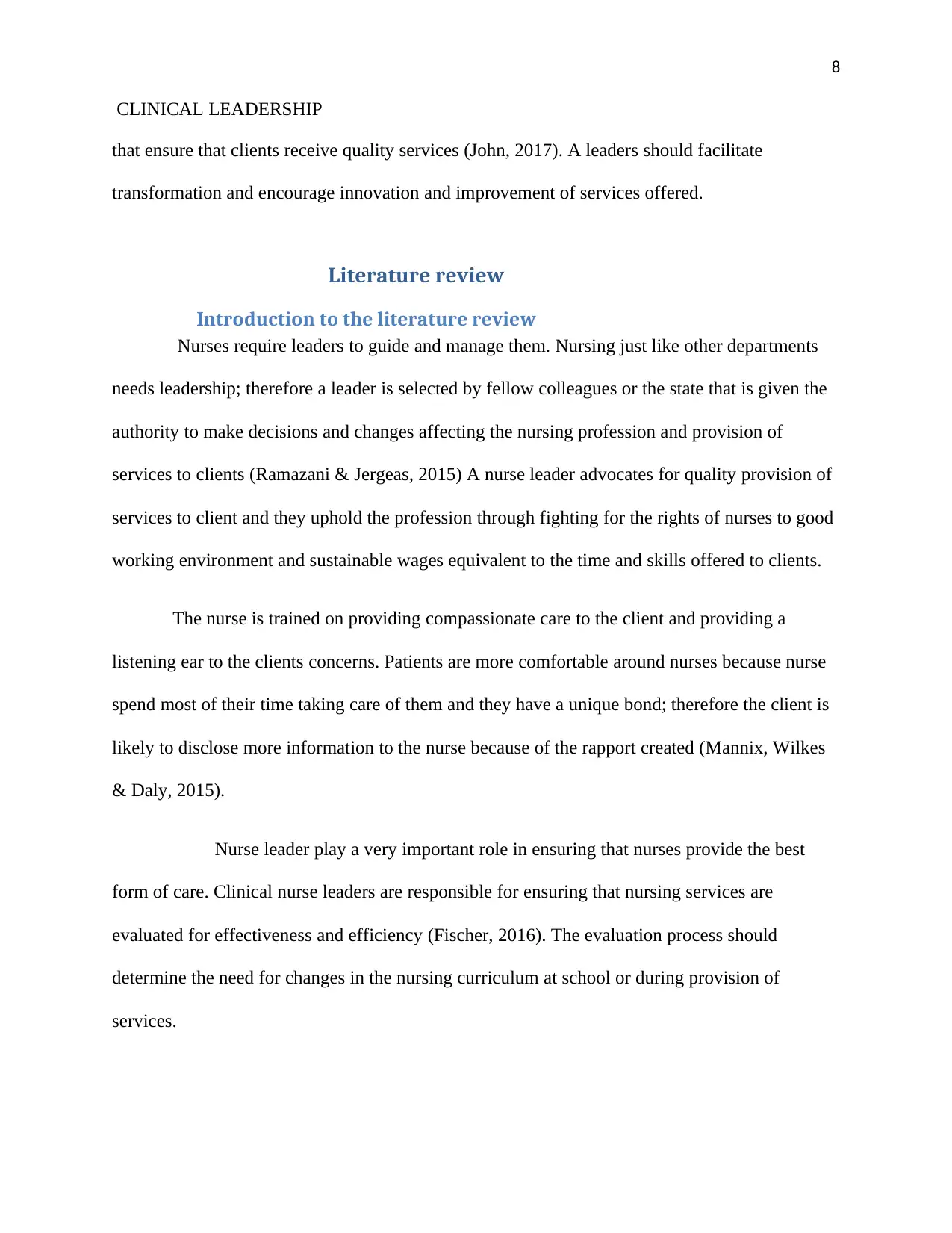
8
CLINICAL LEADERSHIP
that ensure that clients receive quality services (John, 2017). A leaders should facilitate
transformation and encourage innovation and improvement of services offered.
Literature review
Introduction to the literature review
Nurses require leaders to guide and manage them. Nursing just like other departments
needs leadership; therefore a leader is selected by fellow colleagues or the state that is given the
authority to make decisions and changes affecting the nursing profession and provision of
services to clients (Ramazani & Jergeas, 2015) A nurse leader advocates for quality provision of
services to client and they uphold the profession through fighting for the rights of nurses to good
working environment and sustainable wages equivalent to the time and skills offered to clients.
The nurse is trained on providing compassionate care to the client and providing a
listening ear to the clients concerns. Patients are more comfortable around nurses because nurse
spend most of their time taking care of them and they have a unique bond; therefore the client is
likely to disclose more information to the nurse because of the rapport created (Mannix, Wilkes
& Daly, 2015).
Nurse leader play a very important role in ensuring that nurses provide the best
form of care. Clinical nurse leaders are responsible for ensuring that nursing services are
evaluated for effectiveness and efficiency (Fischer, 2016). The evaluation process should
determine the need for changes in the nursing curriculum at school or during provision of
services.
CLINICAL LEADERSHIP
that ensure that clients receive quality services (John, 2017). A leaders should facilitate
transformation and encourage innovation and improvement of services offered.
Literature review
Introduction to the literature review
Nurses require leaders to guide and manage them. Nursing just like other departments
needs leadership; therefore a leader is selected by fellow colleagues or the state that is given the
authority to make decisions and changes affecting the nursing profession and provision of
services to clients (Ramazani & Jergeas, 2015) A nurse leader advocates for quality provision of
services to client and they uphold the profession through fighting for the rights of nurses to good
working environment and sustainable wages equivalent to the time and skills offered to clients.
The nurse is trained on providing compassionate care to the client and providing a
listening ear to the clients concerns. Patients are more comfortable around nurses because nurse
spend most of their time taking care of them and they have a unique bond; therefore the client is
likely to disclose more information to the nurse because of the rapport created (Mannix, Wilkes
& Daly, 2015).
Nurse leader play a very important role in ensuring that nurses provide the best
form of care. Clinical nurse leaders are responsible for ensuring that nursing services are
evaluated for effectiveness and efficiency (Fischer, 2016). The evaluation process should
determine the need for changes in the nursing curriculum at school or during provision of
services.
⊘ This is a preview!⊘
Do you want full access?
Subscribe today to unlock all pages.

Trusted by 1+ million students worldwide
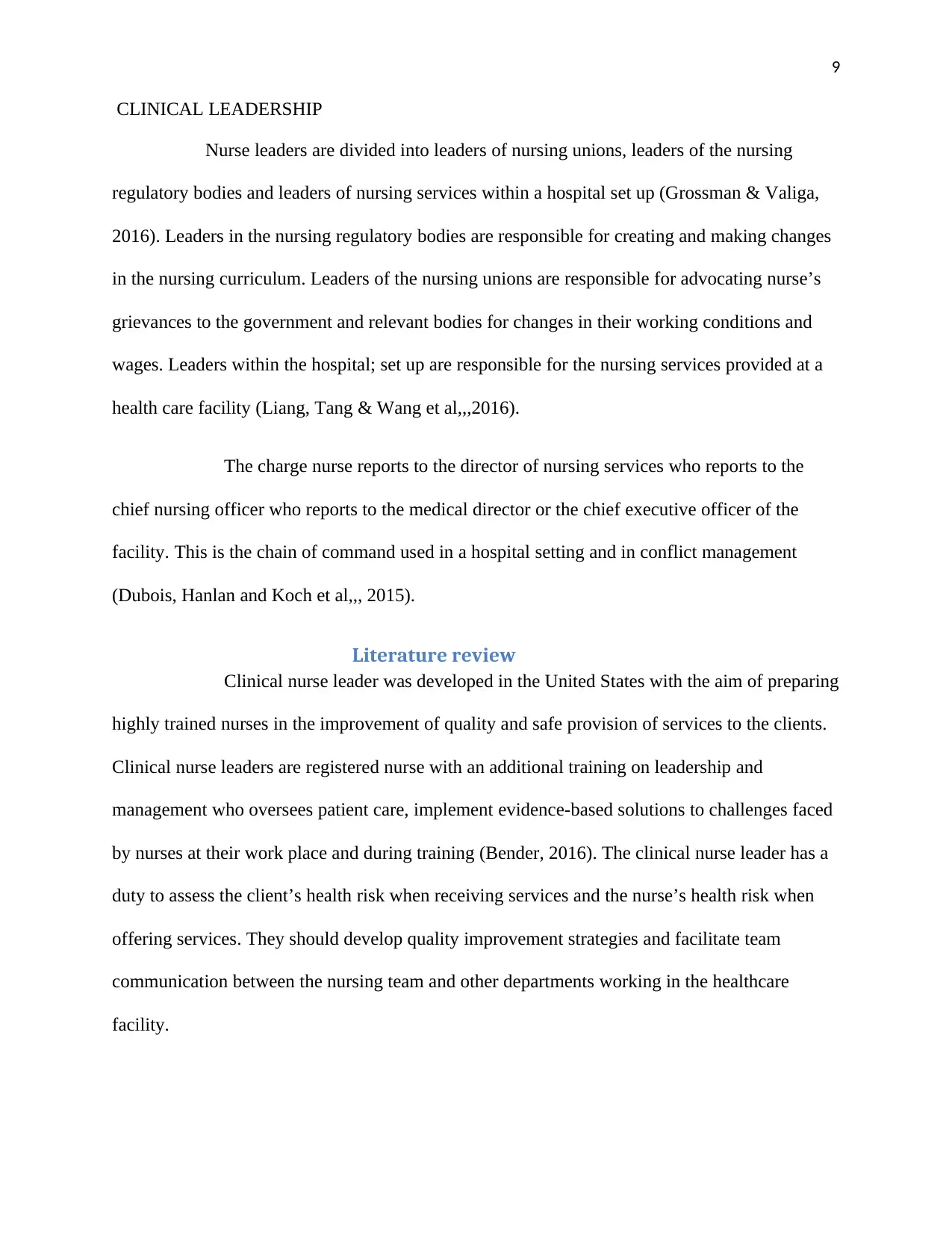
9
CLINICAL LEADERSHIP
Nurse leaders are divided into leaders of nursing unions, leaders of the nursing
regulatory bodies and leaders of nursing services within a hospital set up (Grossman & Valiga,
2016). Leaders in the nursing regulatory bodies are responsible for creating and making changes
in the nursing curriculum. Leaders of the nursing unions are responsible for advocating nurse’s
grievances to the government and relevant bodies for changes in their working conditions and
wages. Leaders within the hospital; set up are responsible for the nursing services provided at a
health care facility (Liang, Tang & Wang et al,,,2016).
The charge nurse reports to the director of nursing services who reports to the
chief nursing officer who reports to the medical director or the chief executive officer of the
facility. This is the chain of command used in a hospital setting and in conflict management
(Dubois, Hanlan and Koch et al,,, 2015).
Literature review
Clinical nurse leader was developed in the United States with the aim of preparing
highly trained nurses in the improvement of quality and safe provision of services to the clients.
Clinical nurse leaders are registered nurse with an additional training on leadership and
management who oversees patient care, implement evidence-based solutions to challenges faced
by nurses at their work place and during training (Bender, 2016). The clinical nurse leader has a
duty to assess the client’s health risk when receiving services and the nurse’s health risk when
offering services. They should develop quality improvement strategies and facilitate team
communication between the nursing team and other departments working in the healthcare
facility.
CLINICAL LEADERSHIP
Nurse leaders are divided into leaders of nursing unions, leaders of the nursing
regulatory bodies and leaders of nursing services within a hospital set up (Grossman & Valiga,
2016). Leaders in the nursing regulatory bodies are responsible for creating and making changes
in the nursing curriculum. Leaders of the nursing unions are responsible for advocating nurse’s
grievances to the government and relevant bodies for changes in their working conditions and
wages. Leaders within the hospital; set up are responsible for the nursing services provided at a
health care facility (Liang, Tang & Wang et al,,,2016).
The charge nurse reports to the director of nursing services who reports to the
chief nursing officer who reports to the medical director or the chief executive officer of the
facility. This is the chain of command used in a hospital setting and in conflict management
(Dubois, Hanlan and Koch et al,,, 2015).
Literature review
Clinical nurse leader was developed in the United States with the aim of preparing
highly trained nurses in the improvement of quality and safe provision of services to the clients.
Clinical nurse leaders are registered nurse with an additional training on leadership and
management who oversees patient care, implement evidence-based solutions to challenges faced
by nurses at their work place and during training (Bender, 2016). The clinical nurse leader has a
duty to assess the client’s health risk when receiving services and the nurse’s health risk when
offering services. They should develop quality improvement strategies and facilitate team
communication between the nursing team and other departments working in the healthcare
facility.
Paraphrase This Document
Need a fresh take? Get an instant paraphrase of this document with our AI Paraphraser
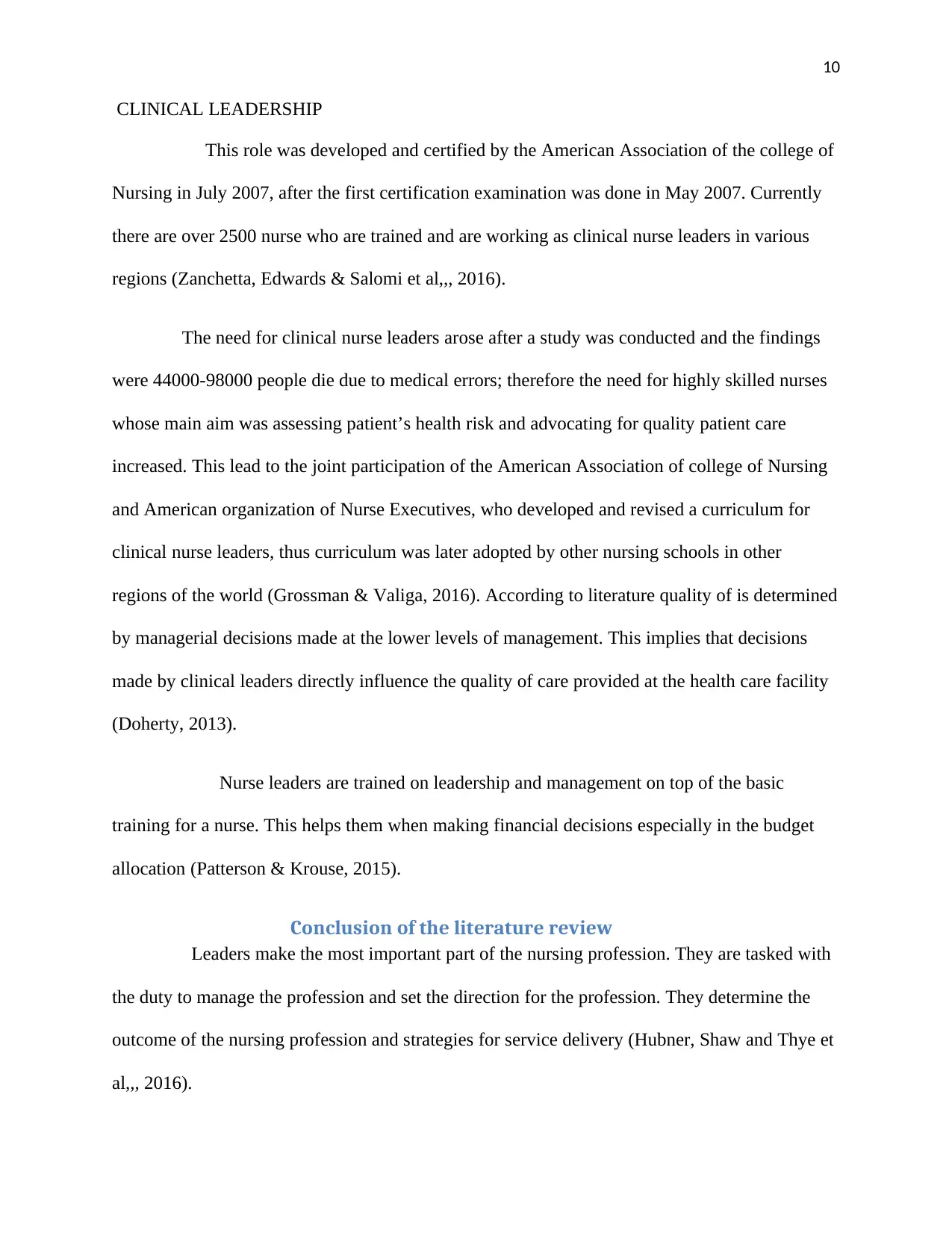
10
CLINICAL LEADERSHIP
This role was developed and certified by the American Association of the college of
Nursing in July 2007, after the first certification examination was done in May 2007. Currently
there are over 2500 nurse who are trained and are working as clinical nurse leaders in various
regions (Zanchetta, Edwards & Salomi et al,,, 2016).
The need for clinical nurse leaders arose after a study was conducted and the findings
were 44000-98000 people die due to medical errors; therefore the need for highly skilled nurses
whose main aim was assessing patient’s health risk and advocating for quality patient care
increased. This lead to the joint participation of the American Association of college of Nursing
and American organization of Nurse Executives, who developed and revised a curriculum for
clinical nurse leaders, thus curriculum was later adopted by other nursing schools in other
regions of the world (Grossman & Valiga, 2016). According to literature quality of is determined
by managerial decisions made at the lower levels of management. This implies that decisions
made by clinical leaders directly influence the quality of care provided at the health care facility
(Doherty, 2013).
Nurse leaders are trained on leadership and management on top of the basic
training for a nurse. This helps them when making financial decisions especially in the budget
allocation (Patterson & Krouse, 2015).
Conclusion of the literature review
Leaders make the most important part of the nursing profession. They are tasked with
the duty to manage the profession and set the direction for the profession. They determine the
outcome of the nursing profession and strategies for service delivery (Hubner, Shaw and Thye et
al,,, 2016).
CLINICAL LEADERSHIP
This role was developed and certified by the American Association of the college of
Nursing in July 2007, after the first certification examination was done in May 2007. Currently
there are over 2500 nurse who are trained and are working as clinical nurse leaders in various
regions (Zanchetta, Edwards & Salomi et al,,, 2016).
The need for clinical nurse leaders arose after a study was conducted and the findings
were 44000-98000 people die due to medical errors; therefore the need for highly skilled nurses
whose main aim was assessing patient’s health risk and advocating for quality patient care
increased. This lead to the joint participation of the American Association of college of Nursing
and American organization of Nurse Executives, who developed and revised a curriculum for
clinical nurse leaders, thus curriculum was later adopted by other nursing schools in other
regions of the world (Grossman & Valiga, 2016). According to literature quality of is determined
by managerial decisions made at the lower levels of management. This implies that decisions
made by clinical leaders directly influence the quality of care provided at the health care facility
(Doherty, 2013).
Nurse leaders are trained on leadership and management on top of the basic
training for a nurse. This helps them when making financial decisions especially in the budget
allocation (Patterson & Krouse, 2015).
Conclusion of the literature review
Leaders make the most important part of the nursing profession. They are tasked with
the duty to manage the profession and set the direction for the profession. They determine the
outcome of the nursing profession and strategies for service delivery (Hubner, Shaw and Thye et
al,,, 2016).
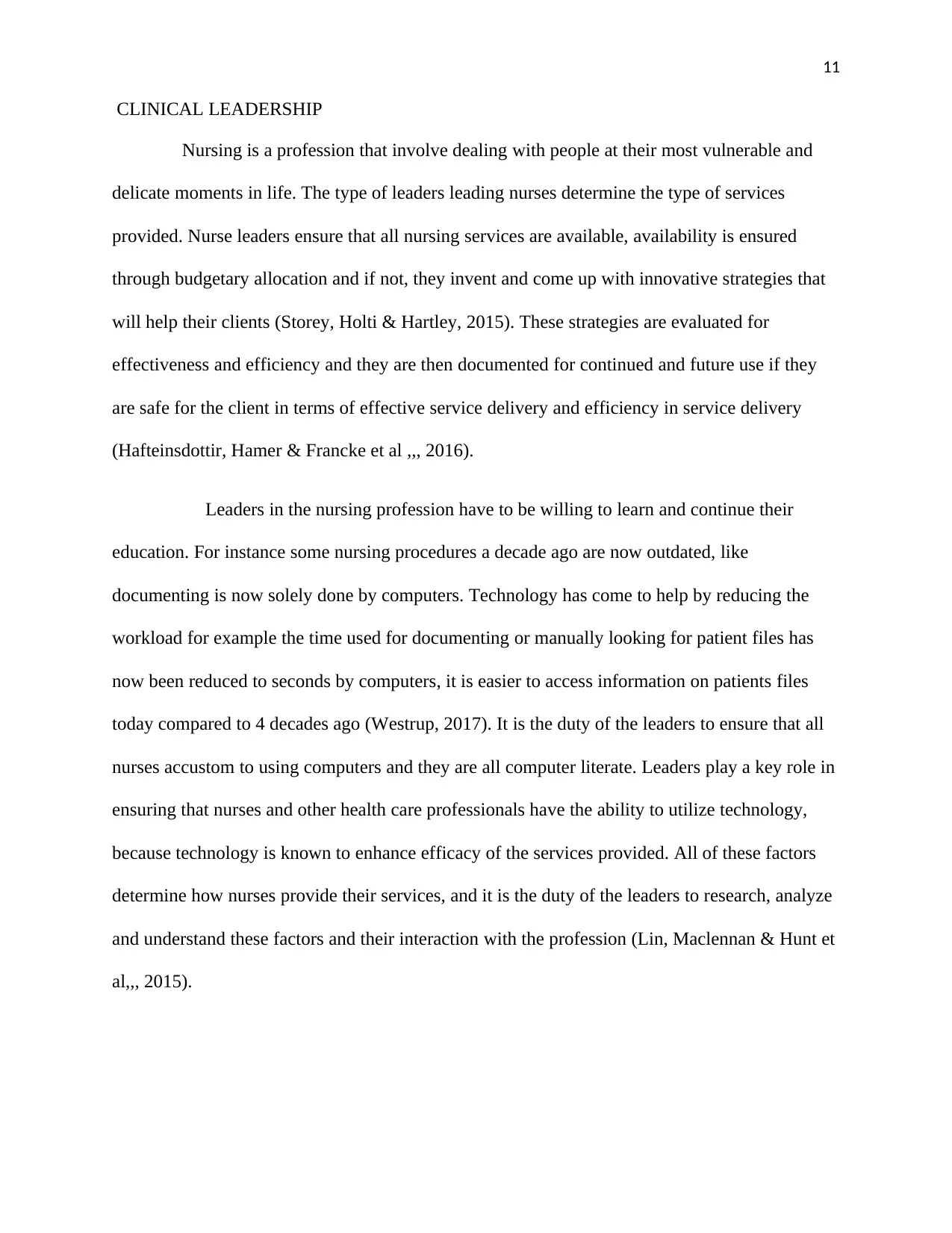
11
CLINICAL LEADERSHIP
Nursing is a profession that involve dealing with people at their most vulnerable and
delicate moments in life. The type of leaders leading nurses determine the type of services
provided. Nurse leaders ensure that all nursing services are available, availability is ensured
through budgetary allocation and if not, they invent and come up with innovative strategies that
will help their clients (Storey, Holti & Hartley, 2015). These strategies are evaluated for
effectiveness and efficiency and they are then documented for continued and future use if they
are safe for the client in terms of effective service delivery and efficiency in service delivery
(Hafteinsdottir, Hamer & Francke et al ,,, 2016).
Leaders in the nursing profession have to be willing to learn and continue their
education. For instance some nursing procedures a decade ago are now outdated, like
documenting is now solely done by computers. Technology has come to help by reducing the
workload for example the time used for documenting or manually looking for patient files has
now been reduced to seconds by computers, it is easier to access information on patients files
today compared to 4 decades ago (Westrup, 2017). It is the duty of the leaders to ensure that all
nurses accustom to using computers and they are all computer literate. Leaders play a key role in
ensuring that nurses and other health care professionals have the ability to utilize technology,
because technology is known to enhance efficacy of the services provided. All of these factors
determine how nurses provide their services, and it is the duty of the leaders to research, analyze
and understand these factors and their interaction with the profession (Lin, Maclennan & Hunt et
al,,, 2015).
CLINICAL LEADERSHIP
Nursing is a profession that involve dealing with people at their most vulnerable and
delicate moments in life. The type of leaders leading nurses determine the type of services
provided. Nurse leaders ensure that all nursing services are available, availability is ensured
through budgetary allocation and if not, they invent and come up with innovative strategies that
will help their clients (Storey, Holti & Hartley, 2015). These strategies are evaluated for
effectiveness and efficiency and they are then documented for continued and future use if they
are safe for the client in terms of effective service delivery and efficiency in service delivery
(Hafteinsdottir, Hamer & Francke et al ,,, 2016).
Leaders in the nursing profession have to be willing to learn and continue their
education. For instance some nursing procedures a decade ago are now outdated, like
documenting is now solely done by computers. Technology has come to help by reducing the
workload for example the time used for documenting or manually looking for patient files has
now been reduced to seconds by computers, it is easier to access information on patients files
today compared to 4 decades ago (Westrup, 2017). It is the duty of the leaders to ensure that all
nurses accustom to using computers and they are all computer literate. Leaders play a key role in
ensuring that nurses and other health care professionals have the ability to utilize technology,
because technology is known to enhance efficacy of the services provided. All of these factors
determine how nurses provide their services, and it is the duty of the leaders to research, analyze
and understand these factors and their interaction with the profession (Lin, Maclennan & Hunt et
al,,, 2015).
⊘ This is a preview!⊘
Do you want full access?
Subscribe today to unlock all pages.

Trusted by 1+ million students worldwide
1 out of 25
Related Documents
Your All-in-One AI-Powered Toolkit for Academic Success.
+13062052269
info@desklib.com
Available 24*7 on WhatsApp / Email
![[object Object]](/_next/static/media/star-bottom.7253800d.svg)
Unlock your academic potential
Copyright © 2020–2025 A2Z Services. All Rights Reserved. Developed and managed by ZUCOL.




